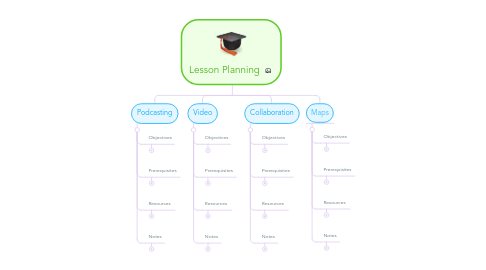
1. Podcasting
1.1. Objectives
1.1.1. M–L3.7 Music Curriculum
1.1.1.1. distinguish between major and minor tonalities
1.1.2. G-1.1 ICT Continuum
1.1.2.1. finds and collects information (text, images, data, audio, video) from given media sources
1.1.3. M-1.1 ICT Continuum
1.1.3.1. demonstrates confidence and self-motivation while doing ICT tasks alone and with others
1.2. Prerequisites
1.2.1. M–L3.6
1.2.1.1. demonstrate understanding that melodic relationships can be transposed to different tonal centres
1.3. Resources
1.3.1. Materials
1.3.1.1. Music Curriculum
1.3.1.2. Informational Podcast
1.3.1.3. Aural Skills Test
1.4. Notes
1.4.1. Lesson or Series Title
1.4.1.1. M–L3 students demonstrate understanding of and facility with rhythm, melody, texture, and harmony in a variety of musical contexts.
1.4.2. Goals of Each Lesson
1.4.2.1. Is the chord Major or Minor?
1.4.2.2. Does it sound happy or sad?
1.4.3. Method of Instruction
1.4.3.1. The teacher will let the students listen to the podcast to teach them the difference of the major and minor chords using an audio program. The program will clearly outline how a chord tonality changes as well as how you "feel" when the chord is played.
1.4.4. Method of Evaluation
1.4.4.1. At the end of the podcast the teacher will pause the podcast and implement a Aural Skills test where the student will listen to several chords and will determine whether they are major or minor. The test will then be assessed by the teacher.
2. Video
2.1. Objectives
2.1.1. K.1.8.B.1
2.1.1.1. Analyze movement concepts in net/wall activities (e.g., body awareness in ready position to receive a serve in badminton...) and target-type activities (e.g., effort qualities in backswing and wrist action on “outturn” in curling...)
2.1.2. G-1.1
2.1.2.1. finds and collects information (text, images, data, audio, video) from given media sources
2.1.3. M-1.1
2.1.3.1. demonstrates confidence and self-motivation while doing ICT tasks alone and with others
2.2. Prerequisites
2.2.1. K.1.8.A.1
2.2.1.1. Recognize characteristics of selected movement skills and patterns (e.g., balance/ready position...) as applied in a variety of physical activities, including net/wall and target activities (e.g., badminton, paddle ball, tennis, curling...)
2.3. Resources
2.3.1. Materials
2.3.1.1. Badminton Wracket
2.3.1.2. Manitoba Physical Education Curriculum
2.3.1.3. Badminton Information
2.3.1.3.1. http://www.badminton-information.com/how-to-play-badminton.html
2.3.2. Facilities
2.3.2.1. Gymnasioum
2.4. Notes
2.4.1. Lesson or Series Title
2.4.1.1. Batminton (Receiving a Serve)
2.4.2. Goals of Each Lesson
2.4.2.1. How do i hold my racket to receive a serve?
2.4.2.2. How to i move to receive the serve?
2.4.3. Method of Instruction
2.4.3.1. The Instructor will show the video demonstrating the proper technique of how to move in order to be able to receive and return a badminton serve. Students will already know how to hold the racket and after lesson will have time to practice with a partner on receiving and returning a badminton serve.
2.4.4. Method of Evaluation
2.4.4.1. After the students have had time to practice receiving multiple Badminton serves the instructor will evaluate the student with a simple test. The instructor will serve four birdies to the student and if the student can return the birdie, with the proper format, the student will receive a mark. After the fourth time the student will receive his or her mark, note that half marks may be appointed if the student has proper movement but does not return birdie. The teacher will then use the mark as a summative assessment.
3. Collaboration
3.1. Objectives
3.1.1. 4.3.1 English Curriculum
3.1.1.1. edit to eliminate fragments and run-on sentences
3.1.2. Co-3.1 Continuum
3.1.2.1. leads a group in the process of collaborative learning
3.1.3. C-2.1 Continuum
3.1.3.1. discusses information, ideas, and/or electronic work using tools for electronic communication
3.2. Prerequisites
3.2.1. No prerequisite required
3.3. Resources
3.3.1. Materials
3.3.1.1. Grade 5 English Curriculum
3.3.1.2. Personal Laptop or Tablet/Google Doc Collaboration
3.4. Notes
3.4.1. Lesson or Series Title
3.4.1.1. General Outcome 4: Enhance the clarity and artistry of communication
3.4.2. Goals of Each Lesson
3.4.2.1. Do your think your purpose is clear to the reader?
3.4.2.2. Do you have enough detail?
3.4.2.3. Is your sentence flowing? Do you have commas in the right place?
3.4.3. Method of Instruction
3.4.3.1. The teacher will instruct the students on the proper way to make conjunction's and how to use commas in a sentence. The students will then join in on the teachers Google Doc and will each write their own sentence. The teacher and students will work with the individual to make proper sentences and how to use commas properly.
3.4.4. Method of Evaluation
3.4.4.1. The individual student will compose a sentence using the collaboration tool on the Google Docs program and the other students and teacher will guide the student in the right direction. Once the student has completed his or her sentence the teacher will be able to assess the sentence to make sure everything is grammatically proper, and will assist the student further. Once all students have complete their sentence they will compose a short story on their own to be handed in for further assessment.
4. Maps
4.1. Objectives
4.1.1. 4-KL-019 SS Curriculum
4.1.1.1. Locate the provinces, territories, and capital cities on a map of Canada. Locate the provinces, territories, and capital cities on a map of Canada.
4.1.2. G-2.3 ICT Continuum
4.1.2.1. categorizes information using the ICT suitable for the purpose
4.1.2.2. Prerequisites
4.1.3. M-1.1 ICT Continuum
4.1.3.1. demonstrates confidence and self-motivation while doing ICT tasks alone and with others
4.2. Prerequisites
4.2.1. 4-KL-018
4.2.2. Locate the oceans, major landforms, lakes, and waterways on a map of Canada.
4.3. Resources
4.3.1. Materials
4.3.1.1. Grade 4 Social Studies Curriculum
4.3.1.2. Grade 4 Social Studies Textbook
4.3.1.3. Google Maps-Technology
4.4. Notes
4.4.1. Lesson or Series Title
4.4.1.1. Geography of Canada
4.4.2. Goals of Each Lesson
4.4.2.1. Where are the provinces and territories of Canada?
4.4.2.2. Where are the capitals of each province?
4.4.3. Method of Instruction
4.4.3.1. Teacher will use a Google Map to outlining where each province, territory, and capitals are located in Canada.
4.4.4. Method of Evaluation
4.4.4.1. Students will then create their own map, a replica of the teachers, as a final evaluation of the lesson.
